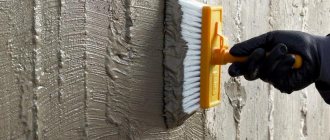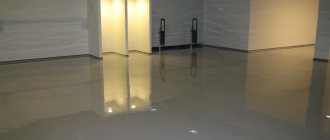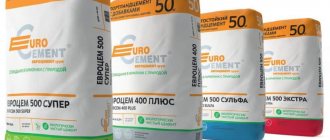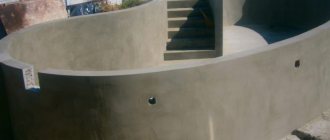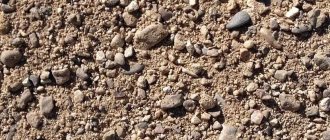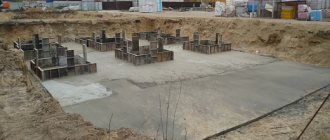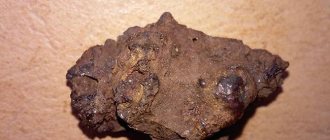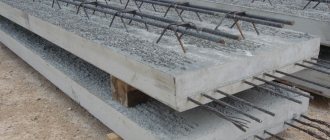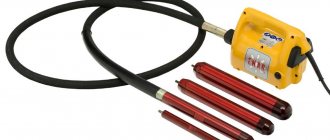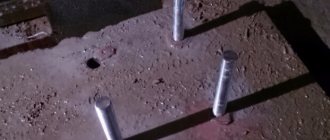Moisture and water are two main factors that have a negative impact on the durability and performance characteristics of concrete structures. Penetrating into walls, foundations, and roofs, they cause the formation of cracks and other defects. The only way to eliminate this destructive effect is to carry out waterproofing work.
Pasting (TechnoNIKOL, Gidroizol, Technoelast, Tefond)
Pasted insulation consists of multilayer elastic membranes, bitumen waterproofing and polymer films. Fastening any material can be done in three ways: fusing with a torch, mechanical fastening, gluing to bitumen mastic . Plus, self-adhesive films have appeared on the market, which have become a godsend in conditions of high fire safety.
Rolled, adhesive coatings contribute to the formation of a sealed, waterproof layer
Protection is carried out on the basis of sheet, roll, polymer, bitumen, bitumen-polymer materials:
- laminated bitumen waterproofing is a very popular option due to its general availability and low price. A prominent representative of materials of this type is Gidroizol. It demonstrates resistance to cracking, destruction, and rotting. The base is fiberglass, fiberglass or polyester, impregnated with a composition of bitumen with plasticizers. There are two options - double-sided bitumen waterproofing (covered on both sides with a low-melting polymer film), single-sided (there is a layer of granite or mineral chips on top);
- lining (roll) bitumen-polymer – here we are talking about a combination of bitumen and modified polymer additives. These can be elastomers, plastic polymers, known as SBS. Additives work to improve technological and operational characteristics. The finished layer retains elasticity even in cold weather and resists temperature loads, biological effects, and ultraviolet radiation. This category includes the fairly high-quality material Technoelast. It is based on polyester, which is very, very practical. This is the optimal solution for foundations, blind areas, roofing, swimming pools, bridges, canals;
- adhesive polymer waterproofing (films and membranes) - we can say that this is a kind of breakthrough, because it is based on innovative technologies. These are materials based on vulcanized rubber, self-adhesive polyethylene films, TPO membranes, EPDM, LDPE, HDPE. If we talk about membranes, their minimum thickness prevents shrinkage during compression. Great strength, durability, elongation at break work great on exterior concrete. The surface of the membranes can be smooth or corrugated.
The protection system is arranged in the form of interconnected sheets. Roll waterproofing is glued onto pre-primed concrete (adhesive mastics and primers are used for this) and fused using special equipment.
Depending on the actual characteristics of the concrete structure and the requirements of the project, several layers and additional protective structures may be implemented. The method is often combined with the use of coating waterproofing . Mastics improve the adhesion of rolls to concrete, acting as an intermediate layer.
Scope of application : waterproofing basements, foundations, infrastructure facilities, wells, roof protection.
Advantages:
- high waterproofing - if the installation technology is followed, the finished layer can withstand strong water pressure and dynamic loads;
- simple installation - materials of this type can be installed in the shortest possible time;
- It is convenient to cover large working surfaces with adhesive waterproofing, incl. vertical;
- the structure is resistant to external influences - in addition to protection from water, we can talk about protection from ultraviolet radiation, high temperatures, and mechanical wear;
- high strength.
Flaws:
- it is necessary to use bitumen, sometimes primers and high temperature compounds;
- Polymer glued waterproofing is available at a high cost and is characterized by low vapor permeability.
Rolled waterproofing can be used to insulate any vertical and horizontal surfaces
Specifications
| Type of waterproofing | Bitumen-polymer | Bituminous | Polymer |
| Roll width/length, m | 1.0/8.0 | 1.0/10.00 | 1.0-2.5/10 |
| Service life, years | Over 30 | 5-10 | Over 50 |
| Operating temperature, degrees | -30 +85 | -30 +80 | -5 +80 |
| Weight, kg/m2 | 5.5 | 4 | — |
| Area per package, m2 | — | 10 | — |
| Base | — | Fiberglass | — |
| Welded side | Polymer film | Protective polymer film | — |
| Upper side | Sand | Coarse powder | — |
Coating (Ceresit, Litocol, Osnovit, Knauf, Webertec, liquid glass)
These are all kinds of bitumen mastics, cement, polymer materials, mastics with sealants. The materials are applied with a spatula, rollers, brushes, or spraying and form a durable waterproofing film or layer . Glass cloth or fiberglass can be placed between the layers.
This is a solution for waterproofing structures against a backdrop of limited financial resources. In fact, the range of materials is quite economical. However, they can work on vertical and horizontal surfaces and provide protection from groundwater, condensation, and precipitation.
This group includes plaster waterproofing mixtures. These are dry compositions on a cement-mineral basis. Decorative plasters are widely used; they are frost-resistant and can withstand aggressive environments. This is the least expensive method of external concrete waterproofing, providing additional protection to the coating layers.
The most effective compositions are made on a bitumen and cement basis . Plus, there must be modifying additives that work to provide unique characteristics. Depending on the tasks, bitumen-polymer and bitumen coating waterproofing can provide anti-corrosion, anti-frost, and antiseptic properties.
Average consumption – 2-3 kg/sq.m. a moisture-resistant thin film of 1-6 mm is formed on the concrete. Scope of application: waterproofing of plinths, foundations, basements, tanks, swimming pools , walls, roofs, balconies, terraces, bridges, tunnels, dams, garages, car washes.
Advantages:
- mastics and paints fill the pores of the base and polymerize, reliably protecting the base. With proper preparation and application technology, the coating can last 50 years without losing its waterproofing properties;
- we can talk about environmental friendliness;
- materials allow you to obtain a durable protective layer;
- ease of application;
- vapor permeability, frost resistance;
- bridging cracks up to 0.9 mm.
Coating waterproofing also provides protection against fungus and mold, the harmful effects of alkalis and acids
Flaws:
- The waterproofing coating is subject to mechanical wear. Protection with plaster or cladding is required.
Technical specifications
| Service life, years | 5 |
| Waterproof | W6 |
| Consumption, 1mm/sq.m | 1.6 kg |
| Operating temperature, degrees | -50 +70 degrees |
Why not do without waterproofing?
For the foundation of a house, any moisture becomes a source of problems, because its elimination is a labor-intensive process that requires additional considerable expenses. Therefore, it is wiser to take care of protecting the foundation during the construction phase.
Foundation waterproofing cannot be neglected because:
When laying a building, the concrete solution leaks into the soil, which significantly weakens the structure in the future.- The foundation of the house is in constant contact with a humid environment, this includes:
- groundwater;
- melt moisture;
- precipitation (snow, rain);
- flooding as a result of seasonal river flooding.
- Unprotected concrete absorbs moisture through capillaries, which crystallizes and expands the foundation, forming cracks.
- It’s not pleasant when there is water in the basement, and the basement cannot be fully used.
- A damp basement in a home becomes a source of mold spreading up the walls.
- The building is being built for more than one decade.
Blocking waterproofing (Ceresit, IVSIL, Litocol, Osnovit, Penetron)
No matter how well the waterproofing work is carried out, there may come a time when the most technologically advanced layer begins to wear out. So, concrete will leak, which will be eliminated by blocking waterproofing. This is a rather interesting group of materials, designed for quick and high-quality removal of leaks and water suction through cracks and cracks.
They use special dry mixtures made on the basis of high-quality cement and silicates. The material is also used to protect monolithic foundations . Polymers contribute to the formation of a durable layer that can absorb large volumes of moisture. In general, these are quick-hardening mixtures that require mixing with water.
Scope of application: stopping leaks in enclosing structures, filling defects in concrete caused by leaks, sealing cracks and holes. .
Advantages:
- steam and waterproofing of target areas;
- excellent strength and ability to work even under high pressure;
- phenomenal resistance to aggressive salt environments;
- record durability;
- no shrinkage;
- high adhesion;
- resistance to mechanical stress.
Flaws:
- work can be carried out at temperatures above +5 degrees;
- high price;
- a professional approach is required.
The average consumption of blocking waterproofing is approximately 1.9 kg/sq.m. per 1 mm layer
Specifications
| Type | Repair composition |
| Type of waterproofing | Hydroseal |
| Service life, years | 5 |
| Waterproof | W8 |
Sealing the seams of floor slabs. Sealing joints between floor slabs with dry mixtures
Ceiling joints can be sealed in several ways:
- using dry mixtures;
- by installing all kinds of suspended structures.
First, let's look at the method of sealing ceiling joints between slabs with cement-based building mixtures. The advantage of this method is its low cost and ease of implementation. In addition, it is reliable, provided, of course, that all work is carried out in strict accordance with the technological process. Before sealing the seams between the floor slabs, it will be necessary to carry out preparatory work to fill all the cracks and further seal them with the necessary materials and tools. They can serve as:
- polyurethane foam;
- narrow brush with steel bristles;
- mounting knife;
- painting mesh;
- starting, finishing and elastic (for example latex) putty;
- perforator;
- container for sealing mixture;
- spray;
- primer;
- several spatulas and brushes of varying sizes;
- sandpaper.
Before covering the seams on the ceiling, begin by pre-cleaning the entire ceiling from old plaster, paint or whitewash. After all the coating has been removed, you will need to calculate the list of upcoming repairs.
As a rule, you will need to seal two or three seams between the ceiling slabs in the same room. Usually, during work, builders seal such cracks inaccurately; many depressions or humps are formed in different places. To achieve the best smoothness of the future ceiling, all these flaws will need to be eliminated.
You need to go over each joint with a hammer drill or hammer in impact mode to remove all the remaining concrete. The gap must be cleaned and deepened so that its depth is at least 5 cm. Next, all dust and smallest particles are removed from the gap. To do this, take a steel bristle brush.
Having completed all the work to remove the old shelf covering and clean the seams, you can be sure that sealing the seams on the ceiling will not be in vain, and the new repaired ceiling will last a long time.
Next, before sealing the joint on the ceiling, its entire surface is subjected to abundant spraying with water from a spray bottle. It is recommended to spray the entire ceiling at once in one approach. The surface moistened with water is left for a quarter of an hour, after which this procedure is repeated again. Similar manipulations are carried out until the entire ceiling is perfectly clean.
Penetrating waterproofing for exterior use (Penetron)
When it is necessary to carry out reliable waterproofing work, there may be several options, since roll and pasting materials do not give up their positions. However, there are situations when it is necessary to carry out large-scale work and then penetrating waterproofing comes to the rescue.
These are dry and liquid compounds that are applied to wet concrete and form a durable crystalline protection . The material penetrates deeply into the mass of concrete, changing its structure, increasing water resistance, strength, and frost resistance. At the same time, the vapor permeability of the base is maintained, that is, the concrete can breathe. And this is exactly the option that can be used for emergency assistance.
Scope of application: waterproofing foundations during laying and construction, repairs, prevention of destruction of concrete structures (roofing, walls, overpasses, bridges, wells, treatment plants), eliminating pressure leaks, sealing cracks, joints, seams. Average consumption – 0.8 kg/sq.m. per 1 mm layer.
Advantages:
- the material forms one whole with the base. The cunning combination of Portland cement, fillers and active additives is characterized by special physicochemical properties. Therefore, the waterproofing seems to merge with the concrete, eliminating the possibility of peeling;
- ease of application - the compositions can be applied not only to the outside, but also to the inside of the structure. The material works even on wet substrates;
- reliability - concrete structures acquire durability and resistance under the pressure of aggressive environments and high temperatures. The bases are strengthened, and at the same time corrosion and the development of mold and mildew are prevented;
- restoration - a unique property of the material - the ability to self-heal cracks.
Flaws:
- the material is applied to the concrete base only under favorable conditions, at a temperature of +5 degrees.
Specifications
| Type of waterproofing | Dry mix |
| Service life, years | 50 or more |
| Waterproof | W20 |
| Frost resistance | Yes |
Ditch, seal, waterproof
Our user with the nickname ALEXUS_81 has constant water in the basement because “a goblin brigade of monolithic workers poured screed onto the floor without any waterproofing or reinforcement.” Because the floor is unprotected, he doesn't see the point in digging out the basement and applying waterproofing to uneven surfaces. All the water has already been pumped out by the pump, but where it comes from is not visible, so the plan to combat basement flooding is as follows:
- To groove and seal all joints between concrete walls and floors;
- Treat all basement walls and floors with penetrating insulation so that there is no more “capillary action.”
ALEXUS_81FORUMHOUSE Member
If all the cracks are caulked and the capillary movement of water is stopped, then there should be no water flow into the basement. Although one unsealed hole may be enough for flooding.
This is what the underground garage of our user with the nickname Magma looked like before the basement was waterproofed:
Water penetrated into the basement through the capillaries of the concrete and through the junction of the floor and the wall. We had to make grooves to dump water into a drainage well with a pump. Water began to flow quite actively from the opened seams, the pump worked in continuous mode. To stop the water, we first had to make hydraulic seals, and then seal the grooves with joint compound. At the last stage, the concrete surface was treated with a penetrating compound.
This is the result that we managed to obtain.
Tools and equipment
The choice of equipment and tools depends on the type of work and materials used.
To install external waterproofing on concrete, use:
- for fusing rolled waterproofing : gas cylinder, reducer, oxygen hose, large gas burner, rolling metal/silicone rollers, carpenter's knife, tape measure;
- for surface preparation : hammer drills, grinders, sandblasting machines, jackhammers, pneumatic hammers, high-pressure devices, a hammer drill with various drilling modes and a set of drills and picks, a screwdriver, metal brushes;
- for applying waterproofing : paint rollers, brushes, spatulas, sprayers with a compressor.
To mix solutions you need: a construction drill with a mixing attachment, clean containers
Applying waterproofing to concrete
The application of waterproofing is always preceded by preparation. This is a responsible and often the most labor-intensive process. Technological operations must be performed with the highest possible quality, otherwise the characteristics of the finished layer will be low.
The choice of method depends on the actual condition of the concrete (degree of destruction, evenness, volume and type of damage):
- mechanical - here they work with jackhammers, wire-needle pneumatic hammers, hammer drills, picks, shotguns, sandblasting machines, grinding machines;
- hydraulic - using high-pressure apparatus at 180-1200 atm;
- thermal - using propane or oxygen burners;
- chemical - using phosphoric or hydrochloric acids.
Purpose of preparation : absence of flaking, loose layers, cracks, especially repeating expansion joints, cavities, chips, dirt, cement laitance, etc.
CemAquaStop
Complex moisture-repellent agent for surface treatment.
More details
At subzero temperatures, the water in the capillaries freezes, increasing in volume and breaking the concrete structure.
Thus, the harmful effects of moisture go in several directions at once, and unprotected concrete can be destroyed in just a few years (destruction of unprotected concrete on the outside of the structure can reach 2 cm per year).
Technology for installing roll external waterproofing
The selected roll material and bitumen primers and sealant tapes are used for work. For roll waterproofing, the evenness of the base should be 5 mm for every 2 m in each direction. Peel strength – not less than 1.5 MPa, humidity – not higher than 4% by weight .
Before applying rolled (covered) waterproofing, all sharp protrusions must be removed from the base, otherwise the material may break. For this purpose, recesses and fillets measuring 100*100 mm are arranged. Material – polymer-cement composition or cement-sand mortar.
Principle of operation:
- cleaned concrete is poured with water until completely saturated;
- prepare the working composition using a construction mixer;
- the composition is applied to the base and a recess or fillet is formed;
- The laid material is provided with wet care (2-3 days) and cured until it reaches full strength.
Application of primer, mastic (priming)
This stage will ensure sufficient adhesion of the rolled materials and concrete (0.5 MPa). Material consumption is 0.25 l/sq.m. The humidity of the base is not higher than 4% by weight; aqueous emulsions can be used at a humidity of 8% by weight. For accurate diagnosis, use a moisture meter.
Application of primer:
- the surface is dusted with a construction vacuum cleaner;
- the material is thoroughly mixed with a construction mixer;
- hard-to-reach areas are finished with brushes with stiff bristles. Even for large volumes of work, it is not recommended to use sprayers;
- the base is kept until the composition dries completely.
The composition is applied to the base using brushes, paint rollers or brushes.
Direction
Fusing onto horizontal bases is carried out using concrete preparation. This will allow you to correctly connect the vertical and horizontal insulation.
Installation of material on horizontal surfaces:
- Using the continuous gluing method, the roll is unrolled and cut with the required overlap. It is advisable to let the material rest in an unfolded state;
- before welding, check the spread of the end seams (it must be at least 500 mm);
- adjacent panels are fused with an end overlap of at least 150 mm, an edge overlap of 100-120 mm;
- in places where T-shaped seams are formed, the corner of the material is trimmed. This will improve the quality of the connection;
- the material is rolled towards the center using a metal pipe. This will make winding more convenient;
- The bottom layer is melted with a burner, while simultaneously heating the base. The device is moved smoothly, focusing on the overlap areas. Gradually roll out the material onto yourself (!);
- The deposited waterproofing should not have waves or folds. The surface is rolled diagonally and axially with a roller;
- if required, the second layer is fused using a similar method, observing overlaps.
When installed on vertical surfaces, material is supplied manually or using traverses or blocks. Work begins from the bottom point, gradually rising upward in stages. The principle of fusing waterproofing remains unchanged.
Technology for applying coating waterproofing
Dusty areas of the concrete structure are blown with compressed air, washed with water, and dried. Potholes and cracks are repaired with cement-sand mortar. There should be no differences on the concrete of more than 2-3 mm for bitumen mastics and more than 3-4 mm for the rest .
The prepared base is primed. For bitumen mastics, a bitumen primer is applied; in other cases, a dust-removing waterproofing primer is applied. Coating waterproofing is applied in two layers, 2-4 mm thick. Polymer and bitumen compositions are ready for use, dry ones are mixed with water . At corners and joints, waterproofing tape is used, which is pressed into the applied layer. A fiberglass mesh can be installed between the first and second layers.
Injection of floor slabs
Reinforced concrete and concrete floor slabs are widely used today in the construction of multi-storey buildings and other multi-tiered structures. Regardless of the purpose of the building, waterproofing is carried out on the floor slabs. Firstly, this prevents annoying leaks to the lower floors in the event of a failure of the sewer system or water supply, and secondly, the waterproofing layer significantly strengthens the floor slab and helps reduce stress caused by loads such as:
- mechanical,
- operational,
- static,
- dynamic.
- Traditionally, a layer of waterproofing was applied during construction work under the floor slab, or on the outside of the building. The introduction of the injection method allows not only to apply an insulating layer on any convenient side of the floor slab, but also to carry out this work at any stage of construction, and even after its completion.
The technology of injecting floor slabs allows the use of a wide variety of materials, these can be:
- cement-sand compositions,
- hydrostructure resins,
- polyurethane mixtures,
- acrylate gels.
cement suspensions,
To achieve maximum insulation quality and create an elastic, durable seam, the selected materials must meet the following requirements:
- low viscosity,
- wide range of temperature conditions,
- adhesion with most building materials,
- durability,
- preventing corrosion of reinforcement.
Acrylate gels and polyurethane resins are recognized as the most popular and superior to other compositions in terms of quality. Injection with these mixtures allows you to create truly reliable protection against leaks, as well as significantly strengthen the floor slab and increase its maintenance-free service life.
Waterproofing concrete with liquid glass
It’s worth talking about liquid glass separately. This composition provides insulation from moisture, has a good effect on the strength of bases, and works even on plastered surfaces. Preparation is carried out in a standard manner.
Liquid glass is based on sodium and potassium silicates
Waterproofing is implemented as follows:
- the material is ready for use and is applied to the base using a roller or brush;
- the first layer should dry for 30 minutes;
- Apply a second layer in an identical manner, and, if necessary, a third, observing the layer-by-layer drying time.
When the surface is completely dry, you can begin applying the adhesive waterproofing.
Documents for redevelopment with the construction of an opening in the floor slab
The design documentation must reflect not only the order in which all work is performed, but also the scheme for reinforcing the opening in the ceiling.
The key official document, on the basis of which, in fact, a project for such a redevelopment will be developed, is the technical conclusion from the author of the house project.
After receiving this document, only an organization with SRO approval should prepare the project. A package of documents, including a technical report and a redevelopment project, along with the application is submitted to the Housing Inspectorate through the one-stop service.
Blocking waterproofing technology
In the place where the leak formed, a dovetail-shaped cavity is created. They take a jackhammer to work. The downward expansion of the recess should be 50 mm, the depth should be at least 25 mm.
Preparation of hydroseal:
- dry powder is mixed with water by volume 4:1, by weight it is 1 kg per 0.22 l of water;
- The mixture is thoroughly kneaded with a construction mixer for no more than 30 seconds. You should get a dense, homogeneous mass. The viability of the hydroseal is 30-40 s.
The composition is pressed forcefully into the recess. Press duration is 40-60 s. The bottom of the cavity must be reached in one movement, ensuring that the solution rests on the concrete. Filling is carried out halfway, after which coating is carried out with a penetrating waterproofing material. The rest of the volume is filled with a composition for sealing seams . Next, the base is moistened and covered again with cement waterproofing. Moisturizing and care is necessary for three days.
What to do if the slab is cracked.
If the cracks on the round-hollow slabs are not very large, then in principle there is nothing to worry about. Almost every house we have built had cracked slabs installed.
Below we will consider the best options for installing cracked slabs so that the minimum load is put on them:
a) If the crack in the slab is large, then we usually place such a slab on the main (or external) wall by 100 - 150 millimeters.
In other words, we install the cracked slab so that it rests on three walls, namely, the ends of the slab rest on the main walls and the long side of the slab also extends and rests on the main wall.
The cracked slab is pressed against the walls above and a completely solid ceiling is obtained.
b) You can also mount a cracked slab where there will be a brick partition underneath it. In other words, the cracked slab will be supported from below by a partition.
c) We install the cracked slab between good, intact slabs
Please pay attention that the rusts between the cracked slab and the good one are well sealed. When the solution in the locks hardens, the ceiling will be solid
d) If you don’t really like the quality of the round-hollow floor slabs (cracks), you can strengthen the screed on these slabs. The screed can be made of concrete, with reinforcement. The result is a reinforced concrete screed that will completely relieve and strengthen the floor slabs.
e) You can mount cracked slabs in places where there will be minimal pressure on them. For example, mount a cracked slab on the very top - the attic floor, where there will be no pressure or support from the roof (rack, etc.) on it.
f) If the slab is severely cracked, forming a gap of 4-10 mm, then it is best to cut such a slab and make it short.
Penetrating waterproofing technology
The main group of materials are cement mixtures that require mixing with water. Work is carried out at temperatures from +5 degrees. Preparation follows general principles.
Mixing the solution:
- the dry cement mixture is placed in a clean container (about 5-7 kg);
- Water is introduced into the material at a temperature of at least 20 degrees. Otherwise, it will affect the setting of the solution;
- the proportional ratio of powder and water by volume is 2:1. By weight, this is 1 kg of composition per 400 ml of liquid;
- the waterproofing is kneaded with a drill with a mixing attachment at low speed for no more than 2 minutes;
- the composition is ready for use, but requires periodic stirring during application. No additional water should be added.
The mixture is applied to the concrete using a sprayer or brush. The first layer is applied to a well-moistened base, the second - as soon as the first has dried, but it is additionally moistened. For 72 hours, concrete is protected from mechanical and temperature loads . Requires wet spraying and covering with polyethylene film.
Conditions for pouring a monolith
It should be noted that concrete flooring can only be done in buildings with strong walls. Its pouring in houses with wooden walls is unacceptable, and in buildings with partitions made of lightweight materials, a monolithic slab can be poured only after installing additional steel or reinforced concrete supports underneath it. In addition, buildings with such platforms must be built on stable soil and a strong foundation. If the building you are constructing does not meet these conditions, you should refuse to fill the floor slab with concrete.
Safety precautions
When carrying out work, it is necessary to observe safety precautions when interacting with gas burners and electrical equipment.
All workers must be equipped with personal protective equipment: helmets, respirators, goggles, rubber and cotton gloves, overalls, safety shoes.
It is unacceptable to allow working solutions to come into contact with the skin and mucous membranes . If this happens, wipe the composition with a clean rag, rinse the area with plenty of water and consult a doctor.
Cost of materials and work for concrete waterproofing
The financial costs of applying external waterproofing depend on the treatment method used, the type of materials, and the characteristics of the concrete base. On average, preparing concrete will require a cost of 20 rubles/sq.m. Application of waterproofing – from 400 RUR/sq.m.
The cost of materials is as follows:
- roll - from 360 r/m.p.;
- hydroseal - from 300 rubles/kg;
- penetrating - from 230 rubles/kg;
- coating - from 400 rubles/30 kg.
conclusions
Saving on waterproofing can lead to fatal consequences. However, the wrong choice of material leads to the same unfavorable results.
When choosing, you should be guided by the following principles:
- lining - with such waterproofing you can save money. Membranes and bitumen-polymer, bituminous materials will reliably protect vertical and horizontal concrete structures subject to precipitation and dynamic loads;
- coating - solutions and mastics are also economical, but are optimally suited for protecting concrete from capillary moisture. This is a weak solution for places where there are deformations and vibration loads. Plus, it is recommended to protect the coating waterproofing with plaster products;
- penetrating is a line of specialized materials that penetrate the thickness of concrete and protect the most critical structures. Highly effective but expensive solution;
- armoring is the optimal method for emergency liquidation of leaks.
If we talk about external parameters, not a single waterproofing material contributes to the decoration of concrete, but all of them allow the installation of finishing coatings.
The reasons for waterproofing concrete and how to implement it are convincingly described in the video:
